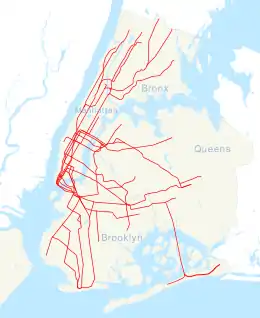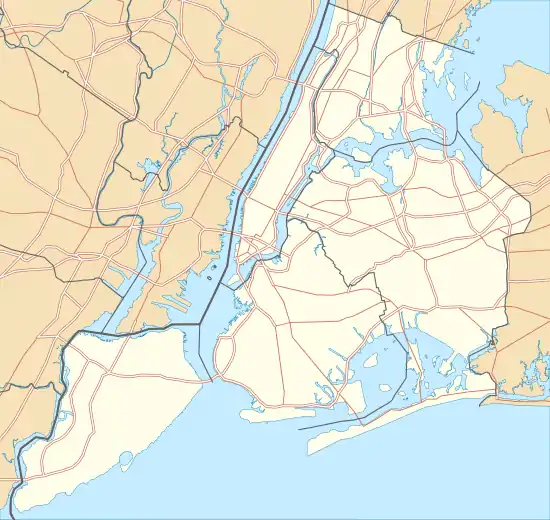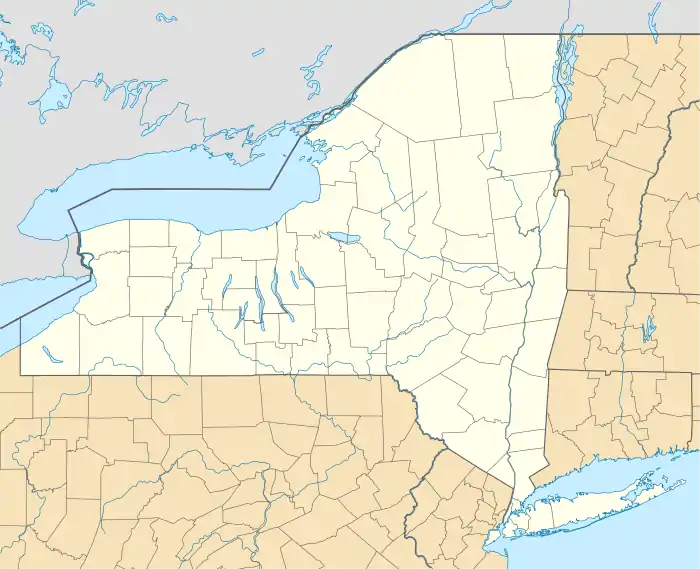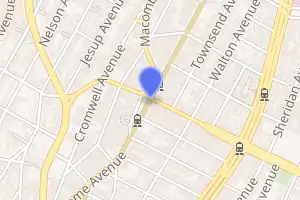170th Street station (IRT Jerome Avenue Line)
170th Street is a local station on the IRT Jerome Avenue Line of the New York City Subway. Located at the intersection of 170th Street and Jerome Avenue in the Bronx, it is served by the 4 train at all times. This station was constructed by the Interborough Rapid Transit Company as part of the Dual Contracts and opened in 1917.
170 Street | ||||||||||||||||||||||||||||||||||||||||||||||||||||||||||||||||||||
|---|---|---|---|---|---|---|---|---|---|---|---|---|---|---|---|---|---|---|---|---|---|---|---|---|---|---|---|---|---|---|---|---|---|---|---|---|---|---|---|---|---|---|---|---|---|---|---|---|---|---|---|---|---|---|---|---|---|---|---|---|---|---|---|---|---|---|---|---|
 Western side view from street | ||||||||||||||||||||||||||||||||||||||||||||||||||||||||||||||||||||
| Station statistics | ||||||||||||||||||||||||||||||||||||||||||||||||||||||||||||||||||||
| Address | 170th Street & Jerome Avenue Bronx, NY 10452[1] | |||||||||||||||||||||||||||||||||||||||||||||||||||||||||||||||||||
| Borough | The Bronx | |||||||||||||||||||||||||||||||||||||||||||||||||||||||||||||||||||
| Locale | Highbridge | |||||||||||||||||||||||||||||||||||||||||||||||||||||||||||||||||||
| Coordinates | 40.840178°N 73.917732°W | |||||||||||||||||||||||||||||||||||||||||||||||||||||||||||||||||||
| Division | A (IRT) | |||||||||||||||||||||||||||||||||||||||||||||||||||||||||||||||||||
| Line | IRT Jerome Avenue Line | |||||||||||||||||||||||||||||||||||||||||||||||||||||||||||||||||||
| Services | 4 | |||||||||||||||||||||||||||||||||||||||||||||||||||||||||||||||||||
| Transit | ||||||||||||||||||||||||||||||||||||||||||||||||||||||||||||||||||||
| Structure | Elevated | |||||||||||||||||||||||||||||||||||||||||||||||||||||||||||||||||||
| Platforms | 2 side platforms | |||||||||||||||||||||||||||||||||||||||||||||||||||||||||||||||||||
| Tracks | 3 | |||||||||||||||||||||||||||||||||||||||||||||||||||||||||||||||||||
| Other information | ||||||||||||||||||||||||||||||||||||||||||||||||||||||||||||||||||||
| Opened | June 2, 1917 | |||||||||||||||||||||||||||||||||||||||||||||||||||||||||||||||||||
| Station code | 387[3] | |||||||||||||||||||||||||||||||||||||||||||||||||||||||||||||||||||
| Accessible | not ADA-accessible; currently undergoing renovations for ADA access | |||||||||||||||||||||||||||||||||||||||||||||||||||||||||||||||||||
| Opposite- direction transfer | Yes | |||||||||||||||||||||||||||||||||||||||||||||||||||||||||||||||||||
| Traffic | ||||||||||||||||||||||||||||||||||||||||||||||||||||||||||||||||||||
| 2019 | 2,487,611[4] | |||||||||||||||||||||||||||||||||||||||||||||||||||||||||||||||||||
| Rank | 192 out of 424[4] | |||||||||||||||||||||||||||||||||||||||||||||||||||||||||||||||||||
| Station succession | ||||||||||||||||||||||||||||||||||||||||||||||||||||||||||||||||||||
| Next north | Mount Eden Avenue: 4 | |||||||||||||||||||||||||||||||||||||||||||||||||||||||||||||||||||
| Next south | 167th Street: 4 | |||||||||||||||||||||||||||||||||||||||||||||||||||||||||||||||||||
| ||||||||||||||||||||||||||||||||||||||||||||||||||||||||||||||||||||
| ||||||||||||||||||||||||||||||||||||||||||||||||||||||||||||||||||||
| ||||||||||||||||||||||||||||||||||||||||||||||||||||||||||||||||||||
| ||||||||||||||||||||||||||||||||||||||||||||||||||||||||||||||||||||
History
Construction and opening
The Dual Contracts, which were signed on March 19, 1913, were contracts for the construction and/or rehabilitation and operation of rapid transit lines in the City of New York. The contracts were "dual" in that they were signed between the City and two separate private companies (the Interborough Rapid Transit Company and the Brooklyn Rapid Transit Company), all working together to make the construction of the Dual Contracts possible. The Dual Contracts promised the construction of several lines in the Bronx. As part of Contract 3, the IRT agreed to build an elevated line along Jerome Avenue in the Bronx.[5][6][7]
170th Street station opened as part of the initial section of the line to Kingsbridge Road on June 2, 1917. Service was initially operated as a shuttle between Kingsbridge Road and 149th Street.[8][9] Through service to the IRT Lexington Avenue Line began on July 17, 1918.[10] The line was completed with a final extension to Woodlawn on April 15, 1918.[11] This section was initially served by shuttle service, with passengers transferring at 167th Street.[12][13] The construction of the line encouraged development along Jerome Avenue, and led to the growth of the surrounding communities.[8]
Station renovations
On July 5, 2004, this station, 176th Street, and Fordham Road closed for four months so they could be renovated. As part of the project, new canopy roofs, walls, lighting, staircases, floors, and a public address system would be installed at each station.[14]
As part of the 2015–2019 Metropolitan Transportation Authority (MTA) Capital Program, elevators are being between the platforms and street, which would make the station fully compliant with accessibility guidelines under the Americans with Disabilities Act of 1990.[15] Construction began in July 2020[16][17] and is expected to be completed by January 2022.[18]
Station layout
| P Platform level |
Side platform | |
| Northbound local | ← | |
| Peak-direction express | ← | |
| Southbound local | | |
| Side platform | ||
| M | Mezzanine | Fare control, station agent, MetroCard machines |
| G | Street level | Entrances/exits |
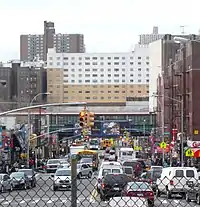
This elevated station has three tracks and two side platforms.[19] The 4 stops here at all times.[20]
Both platforms have beige windscreens, mesh fences, and red canopies with green frames and support columns in the center, and white steel waist-level fences at either ends with white lampposts at regular intervals.
The 2005 artwork here is called Views from Above by Dina Bursztyn. It features stained glass windows on the platform windscreens and station house based on Bursztyn's experience on riding elevated trains.[21]
Exits
The station's main entrance/exit is an elevated station house beneath the tracks. Inside the fare control area, it has two staircases to each platform at the center and a waiting area that allows a free transfer between directions. Outside fare control, it has a turnstile bank, a token booth, and three street stairs going down to either side of Jerome Avenue between 170th Street and Elliot Place, two to the east side and one to the west.[22] Each platform has a secondary fare control area leading to either northern corner of 170th Street and Jerome Avenue, with one staircase from the southbound platform going to the northwestern corner (it had since recently opened) and the other from the northbound platform going to the northeastern corner (still under construction).
References
- "Borough of The Bronx, New York City". Government of New York City. Retrieved December 28, 2020.
- "Bronx Bus Map" (PDF). Metropolitan Transportation Authority. October 2018. Retrieved December 1, 2020.
- "Station Developers' Information". Metropolitan Transportation Authority. Retrieved June 13, 2017.
- "Facts and Figures: Annual Subway Ridership 2014–2019". Metropolitan Transportation Authority. 2020. Retrieved May 26, 2020.
- New Subways For New York: The Dual System of Rapid Transit Chapter 5: Terms and Conditions of Dual System Contracts. New York Public Service Commission. 1913. Retrieved February 16, 2015.
- The Dual System of Rapid Transit (1912). New York State Public Service Commission. 1912.
- "Most Recent Map of the Dual Subway System Which Shows How Brooklyn Borough Is Favored In New Transit Lines". The Brooklyn Daily Eagle. September 9, 1917. Retrieved August 23, 2016 – via newspapers.com.

- "Service Begun on the Jerome Avenue Line". Public Service Record. 4 (6). June 1917.
- Annual report of the Interborough Rapid Transit Company For The Year Ended June 30, 1917. HathiTrust. Interborough Rapid Transit Company. 1917. hdl:2027/mdp.39015016416920.
- Brooklyn Daily Eagle Almanac. The Brooklyn Daily Eagle. 1922. p. 372.
- "Jerome Av. Line Ordered Opened". The New York Times. April 13, 1918. ISSN 0362-4331. Retrieved June 5, 2016.
- Brooklyn Daily Eagle Almanac. The Brooklyn Daily Eagle. 1916. p. 100.
- Cunningham, Joseph; DeHart, Leonard O. (1993). A History of the New York City Subway System. J. Schmidt, R. Giglio, and K. Lang. p. 48.
- "Three Bronx subway stations closed to undergo renovations for four months". news12. July 5, 2004. Archived from the original on June 30, 2020. Retrieved June 30, 2020.
- MTA Board - NYCT/Bus Committee Meeting - 02/20/2018. Metropolitan Transportation Authority. February 20, 2018. Retrieved March 4, 2018 – via YouTube.
- "Capital Program Oversight Committee Meeting June 2020". mta.info. Metropolitan Transportation Authority. June 24, 2020. p. 36. Retrieved September 19, 2020.
- https://www.facebook.com/VanessaGibsonNYC/photos/exciting-news-construction-will-soon-begin-for-our-elevator-at-the-170th-street-/3303017386384648/
- http://web.mta.info/capitaldashboard/allframenew_pi.php?PROJNUM=t7041332
- Dougherty, Peter (2020). Tracks of the New York City Subway 2020 (16th ed.). Dougherty. OCLC 1056711733.
- "4 Subway Timetable, Effective September 13, 2020". Metropolitan Transportation Authority. Retrieved December 9, 2020.
- "170th Street - Dina Bursztyn - Views from Above, 2006". mta.info. Metropolitan Transportation Authority. Archived from the original on June 26, 2020. Retrieved June 26, 2020.
- "170th Street Neighborhood Map" (PDF). mta.info. Metropolitan Transportation Authority. April 2018. Retrieved February 28, 2019.
External links
| Wikimedia Commons has media related to 170th Street (IRT Jerome Avenue Line). |
- nycsubway.org – IRT Woodlawn Line: 170th Street
- nycsubway.org — Views from Above Artwork by Dina Bursztyn (2005)
- Station Reporter — 4 Train
- The Subway Nut — 170th Street Pictures Archived February 23, 2020, at the Wayback Machine
- MTA's Arts For Transit — 170th Street (IRT Jerome Avenue Line)
- 170th Street entrance from Google Maps Street View
- Platforms from Google Maps Street View
